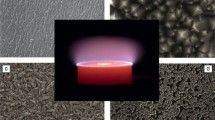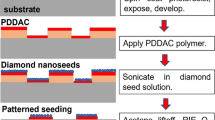Abstract
Polycrystalline diamond films may be produced by chemical vapor deposition (CVD) with morphologies ranging from multimicron crystallites with well-defined facets and texture to nanocrystalline “cauliflower” nodules. While previous efforts to connect diamond film “quality” to growth conditions focus on competitive growth of non-diamond phases, we propose that twinning is a major controlling factor. We use geometric arguments to define the conditions under which a given twin can outgrow and bury the “parent” face on which it originated. We then show how the full spectrum of diamond crystallite shapes and film morphologies can be explained in terms of penetration twins without reference to the actual mechanistics of diamond growth.
Similar content being viewed by others
References
J.C. Angus and C.C. Hayman, Science 241, 913 (1988).
W.A. Yarbrough and R. Messier, Science 247, 688 (1990); W. Piekarczyk and W.A. Yarbrough, J. Cryst. Growth 108, 583 (1991).
J. E. Butler and R. L. Woodin, Philos. Trans. R. Soc. London A 342, 209 (1993).
Ch. Wild, N. Herres, and P. Koidl, J. Appl. Phys. 68, 973 (1990); C. Wild, P. Koidl, W. Müller-Sebert, H. Walcher, R. Kohl, N. Herres, R. Locher, R. Samelenski, and R. Brenn, Diamond Relat. Mater. 2, 158 (1993).
R.E. Clausing, L. Heatherly, L.L. Horton, E.D. Specht, G.M. Begun, and Z.L. Wang, Diamond Relat. Mater. 1, 411 (1992). This twin was only recently conclusively confirmed as a (III) twin by topographic imaging in M. P. Everson, M. A. Tamor, D. Scholl, B. R. Stoner, S. R. Sahaida, and J. P. Bade, J. Appl. Phys. (in press).
J.C. Angus, Z. Li, M. Sunkara, R. Gat, A.B. Anderson, S.P. Mehandiu, and M. W. Geis, Proc. 2nd Int. Symp. on Diamond Materials, Washington, DC, May 5–10, 1991 (The Electrochemical Society, Pennington, NJ, 1991), Vol. 91–8, pp. 125–141.
J. C. Angus, M. Sunkara, S. R. Sahaida, and J. T. Glass, J. Mater. Res. 7, 3001 (1992).
Although there are numerous discussions of penetration twins in the literature, the associated definitions of a penetration twin (usually based on the nature of the grain boundary separating the two members of the twin pair) are not always identical. For example, see A. M. Cody and R. D. Cody, J. Cryst. Growth 83, 485 (1987) or Y. Takano and T. Nishida, Acta Crystallogr. A 28, s119 (1972).
Features that in retrospect can be identified as penetration twins do appear in the literature. For example, see R. E. Clausing, L. Heatherly, K. L. More, and G. M. Begun, Surf. Coating Technol. 39/40, 199 (1989).
Because the behavior of each reactor design is unique and there are several other less influential variables (such as gas pressure and flow rate, filament or plasma temperatures, and various geometric effects), quantifying these variables would be of use only to operators of reactors exactly identical to ours.
A. van der Drift, Philips Res. Rep. 22, 267 (1967).
B.R. Stoner, S.R. Sahaida, J.P. Bade, P. Southworth, and P.J. Ellis, J. Mater. Res. 8, 1334 (1993); B. R. Stoner, C-t. Kao, D. M. Matta, and R. C. Glass, Appl. Phys. Lett. 62, 2347 (1993).
K.V. Ravi and A. Joshi, Appl. Phys. Lett. 58, 246 (1991).
K. Okada, S. Komatsu, T. Ishigaki, S. Matsumoto, and Y. Moriyoshi, J. Appl. Phys. 71, 4920 (1992).
M.P. Everson and M.A. Tamor, J. Mater. Res. 7, 1438 (1992).
Author information
Authors and Affiliations
Rights and permissions
About this article
Cite this article
Tamor, M.A., Everson, M.P. On the role of penetration twins in the morphological development of vapor-grown diamond films. Journal of Materials Research 9, 1839–1849 (1994). https://doi.org/10.1557/JMR.1994.1839
Received:
Accepted:
Published:
Issue Date:
DOI: https://doi.org/10.1557/JMR.1994.1839




